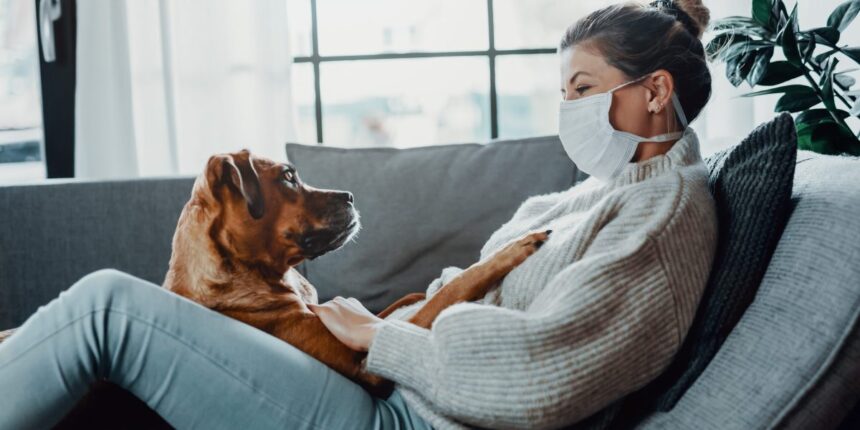
If you’re wondering if you should be steering clear of your dog when you’re sick with COVID, the answer is yes.
Just as COVID-19 can spread from person to person, it can also spread from people to animals, according to the U.S. Centers for Disease Control and Prevention. Animals can spread the virus to people as well, in a process known as zoonotic transmission—though this likely occurs only rarely.
It’s not impossible, though. COVID is thought to have originated in animals—and even if the lab leak theory is true, animals may have played a role in early transmission of the virus.
Raccoon dogs—animals that are more closely related to foxes, susceptible to COVID, and can spread the virus to humans—were thought to be present at the Huanan Seafood Market in Wuhan during the early days of the pandemic, World Health Organization officials announced earlier this year. It’s possible that the dogs brought the virus to the market, where the first known super-spreader event occurred.
How many dogs have come down with COVID?
A couple of online dashboards track cases of COVID reported in animals. One, launched last year by the Wildlife Conservation Society and Australian researchers at the University of Veterinary Medicine Vienna, has documented 174 cases of COVID in dogs worldwide, though there almost certainly have been more.
The only other animals more frequently reported with COVID: cats and American minks.
Symptoms of COVID in dogs
Most pets with COVID have mild symptoms and can be cared for at home. Some won’t display symptoms at all. The following are potential symptoms in pets sick with the virus, according to the CDC and the Wildlife Conservation Society:
• Fever
• Cough
• Difficulty breathing
• Lack of usual energy
• Sneezing
• Runny nose
• Eye discharge
• Vomiting
• Diarrhea
• Neurological symptoms
• Myocarditis (inflammation of the heart)
• Weight loss
How to prevent your dog from getting COVID
The CDC doesn’t currently recommend isolating yourself from family pets if you’re sick with COVID. It does, however, recommend avoiding close contact with animals, just as you would with people. That includes ensuring you’re not doing the following with your pets:
• Petting
• Snuggling
• Kissing
• Sharing food
• Sleeping in the same bed
And there are a couple things you should definitely not do, according to the CDC:
• Don’t mask your pet; this could harm them.
• Don’t wipe or bathe your pet in chemical disinfectants, alcohol, hydrogen peroxide, hand sanitizer, counter-cleaning wipes, or other cleaners. There is no evidence that the virus spreads to people from the skin or fur of pets.
What other animals can get COVID?
The Wildlife Conservation Society’s dashboard documents nearly 900 cases of COVID in 39 countries and 34 species. Those species include:
• White-tailed deer
• Lions
• Tigers
• Snow leopards
• Gorillas
• Pumas
• Asian small-clawed otters
• Large hairy armadillos
• Red foxes
• Brown-headed spider monkeys
• Golden hamsters
• Norway rats
• Spotted hyenas
• Hippos
• Lynx
• Black-tailed marmoset
• Giant anteater
• Squirrel monkey
• Brown wooly monkey
Another COVID-in-animals dashboard is kept by Raj Rajnarayanan, assistant dean of research and associate professor at the New York Institute of Technology campus in Jonesboro, Ark., and a top COVID-variant tracker. According to his, the animals most commonly reported with COVID are:
• Mink (1,328)
• Deer (574)
• Cats (166)
• Dogs (109)
• Lions (72)
Just as COVID can mutate in humans, it can mutate in animals. Thus, an animal with COVID could spawn a new variant or subvariant and transmit it back to humans.
In a worst-case scenario, that new variant would be even more transmissible than the currently dominant Omicron subvariant EG.5 and even more immune-evasive—perhaps even able to outsmart antivirals like Paxlovid.
The most likely culprit in such a scenario may be a bird, due to their migratory nature.
“Birds can migrate and rapidly disseminate novel pathogens,” Dr. Mary Montgomery, a clinician educator in the Division of Infectious Disease at Brigham and Women’s Hospital, a Harvard-affiliated facility in Boston, told Fortune last year. “And there are definitely many cases in literature of other coronaviruses affecting birds.”
Rajnarayanan is among researchers keeping their eyes on the avian population. While the majority of globally identified animal cases have been in mink, deer, and pets like cats and dogs, Rajnarayanan noted last year that COVID had crossed over into the avian population. The first two reported cases were identified in swans in China.
Omicron seems more likely to infect chicken and turkeys than the Delta variant, he told Fortune last year, adding that the avian crossover could eventually have “big implications” like new mutations, extensive spread of the virus, and impacts on food supply.
“Everyone wants to concentrate on mammalian species,” he said. “Now birds enter the picture. We want to monitor this much more closely.”








